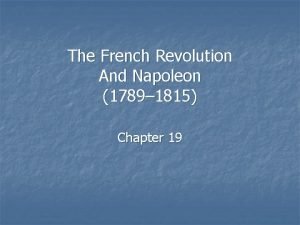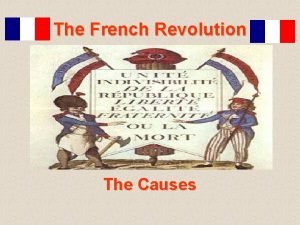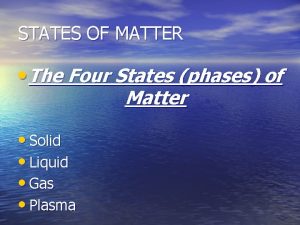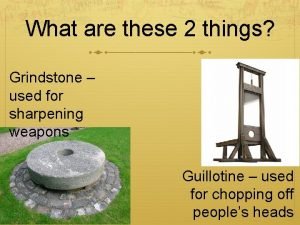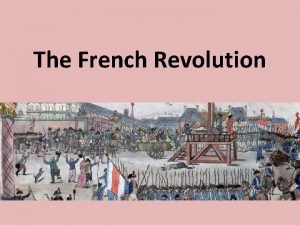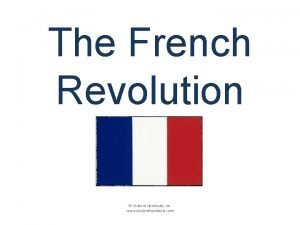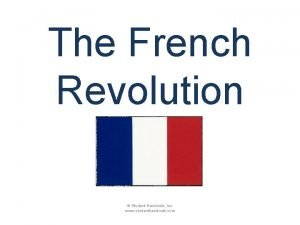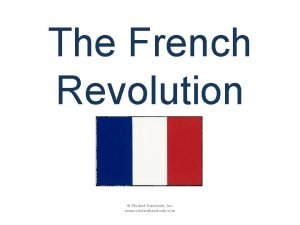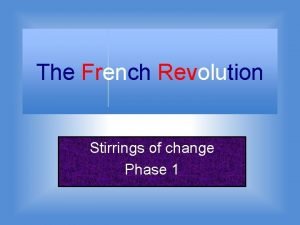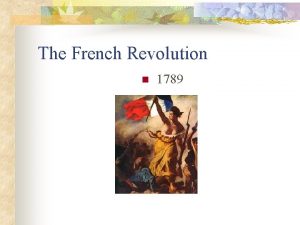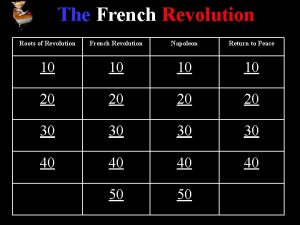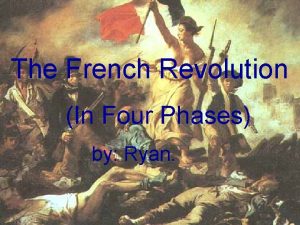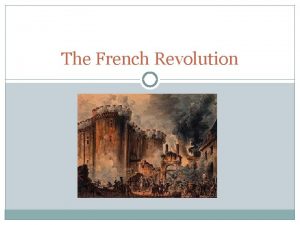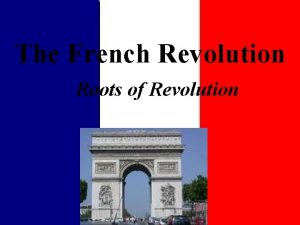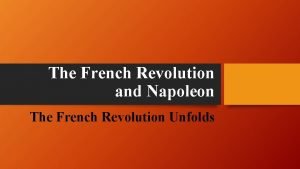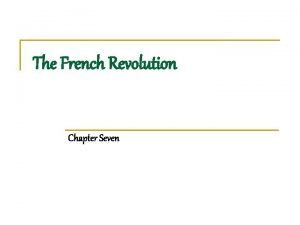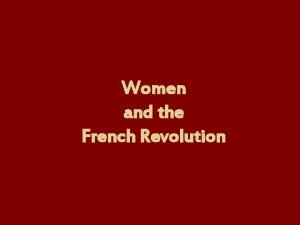THE FRENCH REVOLUTION Four Phases of the French





















- Slides: 21

THE FRENCH REVOLUTION

Four Phases of the French Revolution National Assembly (1789 -1791) Legislative Assembly (1791 -1792) Convention (1792 -1795) Directory (1795 -1799)

LONG TERM CAUSES Everything previously discussed • Absolutism • Unjust socio-political system (Ancien Regime) • Poor harvests which left peasant farmers with little money for taxes • Influence of Enlightenment philosophers Also • System of mercantilism which restricted trade • Influence of other successful revolutions • English Revolution (1688 -1689) • American Revolution (1775 -1783)

SHORT TERM CAUSES Bankruptcy • Caused by deficit spending • Proposed changes • But these were rejected • Assembly voted against taxation for the nobility in 1787 Great Fear Estates-General • Worst famine in memory • Hungry, impoverished peasants feared that nobles at Estates. General were seeking greater privileges • Attacks on nobles occurred throughout the country in 1789 • Louis XVI had to call for a meeting of the Estates-General to find a solution to the bankruptcy problem • All three estates had not met since 1614 • Deadlock resulted in the abolition of the monarchy, the of the Bastille and a completely new sociopolitical system for France

National Assembly (1791 -1792) – p 78

THIRD ESTATE WANTED TO CHANGE THE VOTING SYSTEM First Estate =1 Vote or 130, 000 Votes = e t ta r s E o d r te 00 i o h T 1 V 00, 0 s , 0 25 Vote Se Es co tat nd 11 Vot e = 0, 0 e 1 00 or Vo tes

Tennis Court Oath The Third Estate declared itself to be the National Assembly (the real government of the people). Louis XVI responded by locking the Third Estate out of the meeting. The Third Estate went to a nearby tennis court where its members vowed to stay together until the King accepted a new written constitution for France. On June 23, 1789, Louis XVI relented. He ordered the three estates to meet together as the National Assembly and vote, by population, on a constitution for France.

National Assembly (1789 -1791) Tennis Court Oath • Louis XVI did not actually want the written constitution he had agreed to and sent troops to close down the assembly. • The people (mobs) stormed the Bastille prison in response The Great Fear People in the countryside thought the nobles would burn their crops and starve them into submission. The peasants attacked the nobles and burned many of their chateauxs or castles.


Main Achievements of the National Assembly • The 1791 Constitution in which the king would no longer be an absolute monarch, but subject to parliament in a constitutional monarchy • Political powers were divided (legislative, executive and judicial) and limited suffrage introduced. • The declaration of the Rights of Man and the Citizen: • Freedom of religion • Freedom of speech • “Liberty, equality, fraternity!” • Guaranteed property rights • Right to a fair trial

Legislative Assembly (1791 -1792) -p 79 This new government became known as the Legislative Assembly • Democratic features –France became a limited monarchy –All laws were created by the Legislative Assembly –Feudalism was abolished • Undemocratic features –Voting was limited to taxpayers –Offices were reserved for property owners • Church lands were seized, divided, and sold to peasants • Church officials were elected by the people, with salaries paid by the government (2/3 of Church officials fled the country rather than swear allegiance to this) • All special privileges of the First and Second Estates were abolished

The new government, however, had many opponents both inside and outside of France. • Royal family looked to Austria (Ruled by Emperor Leopold, Marie Antoinette’s brother) for help –In June, 1791, they were caught trying to escape to Austria • Nobles who fled the revolution lived abroad as émigrés –They hoped that, with foreign help, the Old Regime could be restored in France • Church officials wanted Church lands, rights, and privileges restored –Some devout Catholic peasants also supported the Church Marie Antoinette v. Other European monarchs were frightened the revolution would spread to their own countries. • France was invaded by Austria and Prussia.

Two main political forces appeared: the Girondins and the Jacobins (also known as the Montagnard) • The Girondins were moderates and wanted to spread the revolution to other European countries (represented the provincial middle class and intellectuals). • The Jacobins were radicals led by Marat, Danton, and Robespierre (represented the urban working classes and were supported by the sans-culottes of Paris). • People suspected the king of wanting to lose the war against Austria so he could restore Absolute power Robespierre • The Paris mobs attacked the Palace and demanded the king was removed and a Republic established. France was declared a republic and the new government was called the National Convention. sans-culottes

The Convention (1792 -1795) p 80 January 21, 1793 King Louis XVI was tried and condemned to death by one vote (361 -360) for: • Using force against the National Assembly • Secretly plotting to overthrow the Revolution • Attempting to escape from France • Bankrupting the country Other European countries were horrified and Austria, England, Holland, Prussia, Sardinia and Spain formed a Coalition to invade France The war went badly for France and prices rose as a result. The sans-culottes rioted in Paris and in some regions peasants loyal to the king revolted against the moderate Girondin government, who were blamed for the problems. The Jacobins seized power through a parliamentary coup. The Committee of Public Safety was set up and came under the control of Maximilien Robespierre. The Jacobins Reign of Terror began (1793 - 1794).

The Reign of Terror Committee of Public Safety. Decree by Convention, April 1793 on the Committee of Public Safety. “The Committee shall talk in secret; it shall be responsible for watching over the work of the government…under the critical circumstances it is authorised to take measures to defend the revolution against internal and external enemies. ”

Extract from a law introduced by the Committee for Public Safety, 17 th September 1793, to deal with suspects brought to tribunals. “ Suspects shall be locked up…. The proof necessary to convict enemies…can be any kind of evidence…. If proof already exists there need be no further witnesses…. The penalty for all offences under the law of revolutionary tribunal is death. ” Between 3, 000 and 15, 000 people died on the guillotine during the Reign of Terror. 90% were members of the Third Estate, 7% the Second Estate and 3% the First Estate.

Execution Records, 1793. 2. Marie Plaisant, seamstress, convicted of having exclaimed that she was an aritocrat and that she did nots care a fig for the nation, condemned to death and executed the same day. 1. Jean-Baptiste Henry, aged 18, journeyman Tailor, convicted of having cut down a tree of liberty, executed 6 th September, 1793. 3. Henriette Francoise Marboeuf, aged 55, convicted of having hoped for the arrival of the Austrians and Prussians and of keeping food for them, condemned to death and executed the same day. 4. Francois Bertrand, aged 37, publican, convicted of having provided the defenders of the country with sour wine, condemned and executed the same day. The Committee allowed revolutionary tribunals to convict people without hearing evidence. This was called the Law of Prairial. In September 1793, the Convention passed a law called the Law of Suspects. People could now be put in prison without trial.

On July 27, 1794, Partly because of military successes in the wars with European states, the French people revolted against the excesses of the Reign of Terror in what became known as the Thermidorian Reaction. The moderate Girondin members were able to gain control of the convention and Robespierre was arrested and sentenced to death. He was guillotined on July 28, 1794. The Convention approved a new "Constitution of the Year III" on 17 August 1795; a plebiscite ratified it in September; and it took effect on September 26, 1795. The new constitution included a new structure of government Known as the Directory

Government under the Directory Executive Legislature Qualifications • 5 directors appointed by the Legislature • Lower house (500 members) proposed laws • Upper house (250 members) voted on these laws • 2/3 of the Legislature would initially be filled by members of the Convention • Girondists (middle-class party) had defeated the Jacobins (working- and peasant-class party) • Girondists’ constitution stated that suffrage (the right to vote), as well as the right to hold office, were limited to property owners

Directory (1795 -1799) – p 80 • The new régime met with opposition from remaining Jacobins and royalists. • The rule of the Directory was marked by corruption, financial difficulties, political purges, and a dependence on the army to maintain control. • The people of France grew poorer and more frustrated with their government. • Because of military successes, and maybe because of their frustration with the new government, the French had a focal point and a strong feeling of National Pride emerged. Victories in Italy and the defeat of the British in Egypt made Napoleon Bonaparte the most famous general in France. He He would come to power through a coup d’état, ending the ten-year period (1789 -1799) known as the French Revolution.

1. What Paris building was stormed on July 14, 1789? 2. What human rights were established in France by the Declaration of the Rights of Man? 3. What were émigrés, and why did French revolutionaries view them as a threat? 4. Name and describe the two political parties that competed for power in revolutionary France. 5. What was the Committee of Public Safety? 6. Describe the Reign of Terror and explain how it eventually came to an end. 7. Looking back at the first half of 1789, could the French Revolution have been avoided? If so, how?
 What were the four phases of the french revolution
What were the four phases of the french revolution Four phases of the french revolution
Four phases of the french revolution Russian revolution vs french revolution
Russian revolution vs french revolution You should hope that this game will be over soon
You should hope that this game will be over soon Four stages of the french revolution
Four stages of the french revolution Four states of matter
Four states of matter Com3701
Com3701 List the four phases of mitosis in order.
List the four phases of mitosis in order. List the four phases of the business cycle.
List the four phases of the business cycle. Kloc formula
Kloc formula The third agricultural revolution
The third agricultural revolution Grindstone french revolution
Grindstone french revolution French revolution causes and effects
French revolution causes and effects France monarchy timeline
France monarchy timeline Sophie of france (1786-1787)
Sophie of france (1786-1787) Committee of public safety
Committee of public safety French revolution causes
French revolution causes Short term causes of the french revolution
Short term causes of the french revolution The effects of the french revolution
The effects of the french revolution The tennis court oath
The tennis court oath Political causes french revolution
Political causes french revolution French revolution timeline
French revolution timeline

